Abstract
Background
Face-lifting procedures are often performed to hide the effects of aging. Thread-lifting, a minimally invasive technique for the correction of facial aging, has become increasingly popular, and various materials for the procedure have been developed.
Objective
This study compared tissue responses to two types of threading sutures placed under rat skin: polypropylene (PP) monofilament mesh suspension thread (a novel face-lifting material) and polydioxanone (PDO) barbed thread.
Methods
Eight rats each were assigned to the PP monofilament mesh suspension, PDO barbed thread, and control groups. Tissue reactions were evaluated 28 days after subcutaneous loading of the materials.
Results
Significant increases in tensile strength and the mean area occupied by collagen fibers were evident in skin loaded with PDO barbed thread and PP monofilament mesh suspension thread compared to control skin (p<0.05). Compared to sites loaded with PDO barbed thread, those loaded with PP monofilament mesh suspension thread showed a significant increase in the number of collagen fibers and a lower grade of inflammation (p<0.05).
Facial aging is a natural biological process that leads to the thinning, loss of elasticity, and increased laxity of facial skin together with the formation of wrinkles and the atrophy of soft tissues. With aging, connections between muscle and other tissues become weaker, resulting in the gradual development of brow ptosis, orbital rim prominence, deepening of the nasolabial folds, sagging skin and jowl formation12345. Surgical correction of these involutional signs of facial aging67 often yield dramatic improvements. However, there are risks associated with general anesthesia and potential perioperative complications, including hematoma, skin flap necrosis, scar formation, parotid fistulation, and facial nerve injury89. Thus, more durable and less invasive means of face-lifting have been sought1011.
One such procedure is thread-lifting, which is now widely used for brow-, midface-, jowl-, and neck-lifting1213. A specific type of suture material is required to provide sufficient traction/holding power and thus long-lasting effects. Thread-lifting is continuously evolving, including new thread materials and shapes (e.g., by changing the directions of the barbs) and modified fixation techniques. The ideal thread-lifting material induces a minimal inflammatory response and achieves excellent cosmetic results.
Recently, a polypropylene (PP) monofilament mesh suspension thread composed of an implantable distal mesh and a barbed thread became available commercially14. We compared the tissue responses to two types of threading suture after subcutaneous loading under rat skin: PP monofilament mesh suspension thread and polydioxanone (PDO) barbed thread.
Twenty-four healthy male SPF/VAF outbred Crl:CD1 (Sprague Dawley, SD) rats (6 weeks old; OrientBio, Seongnam, Korea, ANNEX I and II) were housed in our animal facility. After 9 days of acclimatization, they were allocated to groups of four, with each group housed together in a polycarbonate cage placed in a temperature- (20℃~25℃) and humidity- (30%~35%) controlled room. The light: dark cycle was 12 hours:12 hours and food and water were supplied ad libitum. Body weights were measured (average, 251.25±11.09 g; range, 235.0~271.0 g) 1 day before placement of the test material (Table 1, Fig. 1). All experimental procedures were conducted in accordance with the National Institute of Health's Guide for the Care and Use of Laboratory Animals (NIH publication no. 85–23, reviewed in 1996). This study was approved by the Institutional Animal Care and Use Committee of Daegu Haany University, Gyeongsan, Korea (no. 88/2016). Then the 24 rats were divided into three groups of eight. Group A consisted of unloaded (control) rats, group B of rats subcutaneously loaded with PDO barbed thread (MIRACU™; Dongbang Medical Co. Ltd., Seongnam, Korea), and group C of rats subcutaneously loaded with PP monofilament mesh suspension thread (RaiseMeUp™; Prestige Medicare Co. Ltd., Seongnam, Korea) (Fig. 2).
PP monofilament mesh suspension thread and PDO barbed thread were supplied as complete kits, which were stored at room temperature with protection from light and moisture.
The two test materials were subcutaneously loaded using needle-type probes after the dorsal hair of the rats was clipped and the area sterilized with povidone iodine (Betadine™; Korea Pharma Co., Hwaseong, Korea). During this procedure, the rats were placed under inhalation anesthesia with 3% (v/v) isoflurane (Hana Pharm. Co., Hwaseong, Korea) in a mixture of 70% N2O and 28.5% O2 (both v/v), administered using a rodent inhalation anesthesia apparatus (Surgivet, Waukesha, WI, USA) and a rodent ventilator (model 687; Harvard Apparatus, Cambridge, UK). The test materials were loaded longitudinally, on the right and left sides of each rat, and then fixed to the loaded sites by skin sutures made with 3–0 black silk, with two ties per test material, at the cephalic and caudal sites. Control rats (group A) underwent hair clipping and skin sterilization with no material loading.
Body weights were measured at day −1, day 0 (the day of subcutaneous loading) and days 7, 14, 21, and 28 after loading, using an automatic electronic balance (Precisa Instrument, Zurich, Switzerland). All animals were fasted overnight (for 18 hours; water was not restricted) prior to test material loading to reduce individual differences caused by feeding behavior.
The rats were sacrificed under inhalation anesthesia and squares of dorsal skin (from both the right and left loading sites) were inverted to observe the subcutaneous regions. Skin tensile strength was measured (in Newtons; N) using a computerized testing device (SV-H1000; Japan Instrumentation System Co., Tokyo, Japan). Equally sized squares from the right side of the dorsal skin, with (groups B, C) or without (group A) loaded test material, were sampled 28 days after subcutaneous loading. The tissue samples were fixed into the machines at two points (cephalic and caudal sites). Peak tensile loads were recorded as skin tensile strength apparent during a 10 mm expansion.
The dorsal skin on the left side (containing the test materials) was sampled 28 days after subcutaneous loading and fixed in 10% (v/v) neutral buffered formalin (NBF) for 24 hours. Individual samples were trimmed and re-fixed in 10% (v/v) NBF. After paraffin embedding, 3 to 4 µm-thick sections were obtained and stained with hematoxylin and eosin (H&E) and Masson's trichrome (MT). The latter identifies collagen fibers. Mast cells were identified with toluidine blue (TB) stain15161718. An experienced pathologist observed the mounted slides under a light microscope (Model Eclipse 80i; Nikon, Tokyo, Japan) at 40×, 100×, and 400× magnification. More detailed information was obtained by determining the mean diameters of the remnant-loaded test materials (in µm), the amount of mast cell infiltration, the inflammatory response around the loaded test materials, and the percentage of tissue occupied by collagen fibers. The inflammatory response was graded according to the greater or lesser presence of inflammatory cells, principally lymphocytes and macrophages under H&E stain (Table 2). Microscopy-based counts from five high-power fields in skin regions with a predominance of inflammatory cells were averaged. The number of mast cells, averaged over eight high-power fields, was counted on TB-stained sections. The percentage of skin region occupied by collagen fiber (per square millimeter of dermis) was calculated from MT-stained sections.
Histomorphometric analyses were done using a computerassisted image-analysis program (iSolution FL ver. 9.1; IMT i-solution Inc., Vancouver, QU, Canada) as described previously15161718 but with a few modifications. One histological field running from the epidermis to the hypodermis in each section, from around the centrally located loading sites, and eight dorsal skin samples from each group, were histopathologically evaluated. At least five repeat measurements were conducted, whenever possible, on the same specimens to calculate mean histomorphometric values. The pathologist was blinded to the group.
All numerical data are expressed as means±standard deviations. Multiple comparison tests were conducted. Homogeneity of variance was examined using Levene's test19. If the result indicated no significant deviation, the data were analyzed using a one-way ANOVA followed by the least-significant difference multi-comparison test to identify pairs of groups that differed significantly. If the Levene test revealed a significant deviation from homogeneity, a non-parametric Kruskal–Wallis H test was conducted. If the latter revealed a significant difference, a Mann–Whitney U test was performed20. The level of significance was set at p<0.05. All statistical analyses were conducted using IBM SPSS Statistics ver. 20.0 (IBM Corp., Armonk, NY, USA).
There were no serious gross findings in the loaded regions of group B and C rats compared to group A control rats, at least not macroscopically (Fig. 4). Significant (p<0.05) increases in skin tensile strength were evident in groups B and C compared to group A, regardless of whether the test materials were intact or remnant (Fig. 5). However, there were no significant differences in the skin tensile strength between groups B and C (p>0.05). After removal of the remnant test materials, significant (p<0.05) decreases in skin tensile strength were evident in both experimental groups compared to the similarly treated control group.
The mean single-filament diameter of remnant material in group B rats was 586.25±26.25 µm, and the mean diameter of remnant bundles in group C rats 574.77±31.6 µm. The bundles in group C rats were composed of fibers of 12 subtypes, with a mean diameter of 120.77±6.25 µm (Table 4, Fig. 6A). The two types of remnant material were observed in the respective rats 28 days after loading, in close proximity to the loading sites.
Inflammatory response grades were significantly (p<0.05) higher around the loaded sites in group B than in those of either group C or group A (Table 4). Most of the infiltrated cells were lymphocytes. (Fig. 6A) Whereas the three groups did not significantly differ (p>0.05) with respect to the mean number of mast cells (Table 4, Fig. 6B).
Significant increases in the mean area occupied by collagen fibers were evident in the skin of group B and C rats compared to the skin of group A rats (Table 4). Moreover, compared to the loaded sites in group B, those in group C were characterized by a significant increase in collagen fibers (p<0.05) (Fig. 6C).
In face-lift procedures, the use of less invasive techniques with minimal risk and short recovery times, such as the S-lift, delta-lift, lower superficial musculoaponeurotic system (SMAS) lift, and more recently, percutaneous suture suspension, are in increasing demand. Percutaneous suspension sutures afford gentle rejuvenation of the face, improving folding, soft-tissue ptosis, and skin redundancy21. Barbed sutures were originally developed in 1992 by Ruff and independently by Sulamanidze et al. in 19961. Wu22 used another type of barbed suture, one that effectively suspends sagging tissue from the stable tissue of the temporal scalp. Isse developed the Isse endo-progressive face-lift suture, made of PP filaments with unidirectional barbs that become anchored to the temporalis fascia. Contour threads consist of 25 cm lengths of 2–0 PP suture material including a central 10 cm segment that contains 50 unidirectional, helicoidally configured barbs. The silhouette lift suture is a nonabsorbable PP 3–0 suture featuring small knots and flexible cones23.
The many types of threads that are currently available have been developed using different materials and different synthetic cog structures. The latter can be generally classified into three types: non-barbed sutures, bidirectionally barbed non-anchored sutures, and unidirectionally barbed anchored sutures24. Recently, a PP mesh suspension thread featuring an implantable distal mesh and a barbed thread was introduced. PP meshes are used in many fields of surgery besides face-lifts. For example, the use of a mesh supporting system in a double-skin technique for mammoplasty and in the closure of the abdominal wall in numerous other operations has been reported2526. The advantages of PP monofilament mesh suspension thread include increased tensile strength and placement in the sub-SMAS plane. The tensile strength (apart from that afforded by the cogs) is increased by the distal mesh while the pore size (<1 mm) of the mesh results in less-extensive scar formation. Furthermore, a separate mesh segment is used for fixation to the deep temporal fascia, which increases both thread stability and the longevity of the lifting effect27. Kwon et al.28 demonstrated that a PP mesh had sufficient mechanical strength and stretching force for use in brow suspension. Pak et al.25 also used PP mesh in nasolabial folds and reported that there were no serious adverse effects in treated patients. However, as with every newly developed procedure and the associated materials, there are benefits and drawbacks that must be carefully evaluated.
In the present work, significant increases (p<0.05) in skin tensile strength and the mean area occupied by collagen fibers were evident 28 days after subcutaneous loading with PP monofilament mesh suspension thread and PDO barbed thread, compared to control rats. In addition, significant increases in collagen fibers were seen in the sites loaded with PP monofilament mesh suspension thread vs. PDO barbed thread (p<0.05). However, the difference in tensile strength between skin loaded with PDO barbed thread and PP monofilament mesh suspension thread was not significant (p>0.05). Increases in tensile strength and collagen fibers have been associated with skin rejuvenation1724272930313233. Our results suggest that the two test materials induce similarly potent collagen deposition and increases in skin tensile strength, both of which are closely related to skin rejuvenation.
Materials appropriate for the treatment of skin aging should remain at the loading site and should not cause serious local irritation153435. In this study, compared to control skin, sites loaded with PDO barbed thread exhibited a significantly (p<0.05) more intense inflammatory response, whereas this was not the case in sites loaded with PP monofilament mesh suspension thread. In their study of meshes used to repair abdominal wall incisional defects, Pereira-Lucena et al.36 suggested that the absorbable materials in composite meshes prolong the inflammatory tissue reaction and that an intense inflammatory reaction might reduce tissue maturation and collagen deposition. Pascual et al.37 also demonstrated that the use of meshes containing absorbable biological materials could increase the production of inflammatory mediators. Maeda et al.38 compared four different types of mesh: high-density PP, low-density PP, PP mesh encapsulated with oxidized cellulose–coated PDO, and expanded polytetrafluoroethylene. On postoperative day 28, the inflammatory scores of the low-density PP group were lower than those of all other groups38. Our work also suggests that the use of absorbable biological materials, such as PDO, can prolong the inflammatory tissue reaction compared to PP. Long-term safety is the another important concern in the use of non-absorbable threads for aesthetic purposes. However, recent studies using PP monofilament suspension thread reported no major side effects at 6 or 12 months1427. Mutaf39 also reported the PP mesh lifting in the brow did not induce a foreign-body reaction during the 6 months to 4 years of follow-up. A study of 350 patients who underwent an Aptos procedure using PP barbed monofilament also reported no major complication over a 43-month period12.
Overall, compared to PDO barbed thread, PP monofilament mesh suspension thread resulted in better collagen deposition while affording comparable skin tensile strength. The PP monofilament mesh suspension thread was also well preserved and remained at the loading site, where at 28 days it was associated with a less inflammatory response than seen at sites loaded with PDO barbed thread. Thus, PP monofilament mesh suspension thread may be a safe and effective thread-lifting material for the treatment of aging skin.
This study had several limitations, including the small number of animals in each group and the relatively short follow-up period. In addition, because we compared PP monofilament mesh suspension with PDO barbed thread rather than traditional PP thread, whether the difference in efficacy and safety were due to the PP material itself or to the newly developed implantable mesh could not be determined. Further work is needed to evaluate the longer-term efficacy and safety of PP monofilament mesh suspensions in human facial skin.
ACKNOWLEDGMENT
This work was supported by the National Research Foundation of Korea (grant no. NRF-2018R1C1B5042271) and the Soonchunhyang University Research Fund. This work was also (partly) supported by the Bio-Meditech Regional Innovation Center at Eulji University, under the Regional Innovation Center Program (2016-02-01) of Ministry Of Trade, Industry and Energy.
References
1. Sulamanidze MA, Fournier PF, Paikidze TG, Sulamanidze GM. Removal of facial soft tissue ptosis with special threads. Dermatol Surg. 2002; 28:367–371. PMID: 12030865.

2. Nkengne A, Bertin C. Aging and facial changes--documenting clinical signs, part 1: clinical changes of the aging face. Skinmed. 2013; 11:281–286. PMID: 24340467.
3. Kazinnikova OG, Adamian AA. Age-specific changes in facial and cervical tissues: a review. Ann Plast Recontr Aesthetic Surg. 2000; 1:52–61.
4. Mitz V, Peyronie M. The superficial musculo-aponeurotic system (SMAS) in the parotid and cheek area. Plast Reconstr Surg. 1976; 58:80–88. PMID: 935283.

5. Owsley JQ. Lifting the malar fat pad for correction of prominent nasolabial folds. Plast Reconstr Surg. 1993; 91:463–474. discussion 475-466. PMID: 8438018.

6. Kang MS, Shin JS, Nam SM, Park ES. Evaluation of elastic lift for facial rejuvenation. Arch Aesthetic Plast Surg. 2016; 22:20–27.

7. Paul MD, Calvert JW, Evans GR. The evolution of the midface lift in aesthetic plastic surgery. Plast Reconstr Surg. 2006; 117:1809–1827. PMID: 16651954.

8. Kaminer MS, Bogart M, Choi C, Wee SA. Long-term efficacy of anchored barbed sutures in the face and neck. Dermatol Surg. 2008; 34:1041–1047. PMID: 18462425.

9. Derby BM, Codner MA. Evidence-based medicine: face lift. Plast Reconstr Surg. 2017; 139:151e–167e.
10. Sapountzis S, Kim JH, Li TS, Rashid A, Cruz PC, Hwang YS. Successful treatment of thread-lifting complication from APTOS sutures using a simple MACS lift and fat grafting. Aesthetic Plast Surg. 2012; 36:1307–1310. PMID: 23052379.

11. Park TH, Seo SW, Whang KW. Facial rejuvenation with fine-barbed threads: the simple Miz lift. Aesthetic Plast Surg. 2014; 38:69–74. PMID: 23812613.

12. Lycka B, Bazan C, Poletti E, Treen B. The emerging technique of the antiptosis subdermal suspension thread. Dermatol Surg. 2004; 30:41–44. discussion 44. PMID: 14692925.

13. Abraham RF, DeFatta RJ, Williams EF 3rd. Thread-lift for facial rejuvenation: assessment of long-term results. Arch Facial Plast Surg. 2009; 11:178–183. PMID: 19451452.
14. Han SE, Go JY, Pyon JK, Oh KS. A prospective evaluation of outcomes for midface rejuvenation with mesh suspension thread: “REEBORN lift”. J Cosmet Dermatol. 2016; 15:254–259. PMID: 27086766.

15. Lee HS, Cho HR, Yang KJ, Shin HD, Park BR, Jang HJ, et al. Local irritation test of 3 types of β-glucan after subcutaneous injection in rats. Lab Anim Res. 2006; 22:339–342.
16. Drynda A, Seibt J, Hassel T, Bach FW, Peuster M. Biocompatibility of fluoride-coated magnesium-calcium alloys with optimized degradation kinetics in a subcutaneous mouse model. J Biomed Mater Res A. 2013; 101:33–43. PMID: 22767427.

17. Kim KH, Park SJ, Lee YJ, Lee JE, Song CH, Choi SH, et al. Inhibition of UVB-induced skin damage by exopolymers from Aureobasidium pullulans SM-2001 in hairless mice. Basic Clin Pharmacol Toxicol. 2015; 116:73–86. PMID: 24964914.
18. Kim CG, Kang M, Lee YH, Min WG, Kim YH, Kang SJ, et al. Bathing effects of various seawaters on allergic (atopic) dermatitis-like skin lesions induced by 2,4-dinitrochlorobenzene in hairless mice. Evid Based Complement Alternat Med. 2015; 2015:179185. PMID: 26221169.

19. Levene A. Pathological factors influencing excision of tumours in the head and neck. part I. Clin Otolaryngol Allied Sci. 1981; 6:145–151. PMID: 7016380.

20. Ludbrook J. Update: microcomputer statistics packages. a personal view. Clin Exp Pharmacol Physiol. 1997; 24:294–296. PMID: 9131301.

21. Gamboa GM, Vasconez LO. Suture suspension technique for midface and neck rejuvenation. Ann Plast Surg. 2009; 62:478–481. PMID: 19387144.

23. Maschio F, Lazzaro L, Pizzamiglio R, Perego F, De Biasio F, Parodi PC. Suspension sutures in facial reconstruction: surgical techniques and medium-term outcomes. J Craniofac Surg. 2013; 24:e31–e33. PMID: 23348328.
24. Shiffman MA, Mirrafati S, Lam SM, Cueteaux CG. Simplified facial rejuvenation. Berlin: Springer-Verlag;2008. p. 257.
25. Pak CS, Chang LS, Lee H, Jeong JH, Jeong J, Yoon ES, et al. A multicenter noncomparative clinical study on midface rejuvenation using a nonabsorbable polypropylene mesh: evaluation of efficacy and safety. Arch Plast Surg. 2015; 42:572–579. PMID: 26430628.

26. Moscona RA, Ramon Y, Toledano H, Barzilay G. Use of synthetic mesh for the entire abdominal wall after TRAM flap transfer. Plast Reconstr Surg. 1998; 101:706–710. discussion 711-702. PMID: 9500387.

27. Sapountzis S, Nikkhah D, Kim JH, Seo JD. Novel polypropylene barbed threads for midface lift-“REEBORN Lifting”. Plast Reconstr Surg Glob Open. 2014; 2:e250. PMID: 25506533.

28. Kwon KA, Shipley RJ, Edirisinghe M, Ezra DG, Rose GE, Rayment AW, et al. Microstructure and mechanical properties of synthetic brow-suspension materials. Mater Sci Eng C Mater Biol Appl. 2014; 35:220–230. PMID: 24411372.

29. Fisher GJ, Varani J, Voorhees JJ. Looking older: fibroblast collapse and therapeutic implications. Arch Dermatol. 2008; 144:666–672. PMID: 18490597.
30. Quan T, Shao Y, He T, Voorhees JJ, Fisher GJ. Reduced expression of connective tissue growth factor (CTGF/CCN2) mediates collagen loss in chronologically aged human skin. J Invest Dermatol. 2010; 130:415–424. PMID: 19641518.

31. Treiber N, Maity P, Singh K, Ferchiu F, Wlaschek M, Scharffetter-Kochanek K. The role of manganese superoxide dismutase in skin aging. Dermatoendocrinol. 2012; 4:232–235. PMID: 23467724.

32. Egbert M, Ruetze M, Sattler M, Wenck H, Gallinat S, Lucius R, et al. The matricellular protein periostin contributes to proper collagen function and is downregulated during skin aging. J Dermatol Sci. 2014; 73:40–48. PMID: 24055232.

33. Argyropoulos AJ, Robichaud P, Balimunkwe RM, Fisher GJ, Hammerberg C, Yan Y, et al. Alterations of dermal connective tissue collagen in diabetes: molecular basis of age-dappearing skin. PLoS One. 2016; 11:e0153806. PMID: 27104752.

34. Chang L, Liu XL, Di Fan D, Miao YQ, Zhang H, Ma HP, et al. The efficiency of magnetic hyperthermia and in vivo histocompatibility for human-like collagen protein-coated magnetic nanoparticles. Int J Nanomedicine. 2016; 11:1175–1185. PMID: 27042065.
35. van Essen TH, van Zijl L, Possemiers T, Mulder AA, Zwart SJ, Chou CH, et al. Biocompatibility of a fish scale-derived artificial cornea: cytotoxicity, cellular adhesion and phenotype, and in vivo immunogenicity. Biomaterials. 2016; 81:36–45. PMID: 26717247.
36. Pereira-Lucena CG, Artigiani Neto R, de Rezende DT, Lopes-Filho Gde J, Matos D, Linhares MM. Early and late postoperative inflammatory and collagen deposition responses in three different meshes: an experimental study in rats. Hernia. 2014; 18:563–570. PMID: 24370605.

37. Pascual G, Rodríguez M, Sotomayor S, Pérez-Köhler B, Bellón JM. Inflammatory reaction and neotissue maturation in the early host tissue incorporation of polypropylene prostheses. Hernia. 2012; 16:697–707. PMID: 22744412.

38. Maeda CT, Artigani Neto R, Lopes-Filho GJ, Linhares MM. Experimental study of inflammatory response and collagen morphometry with different types of meshes. Hernia. 2016; 20:859–867. PMID: 27334003.

39. Mutaf M. Mesh lift: a new procedure for long-lasting results in brow lift surgery. Plast Reconstr Surg. 2005; 116:1490–1499. discussion 1500-1501. PMID: 16217500.

Fig. 1
Experimental design of the study. SD rats: Sprague Dawley rats, PDO: polydioxanone, PP: polypropylene.
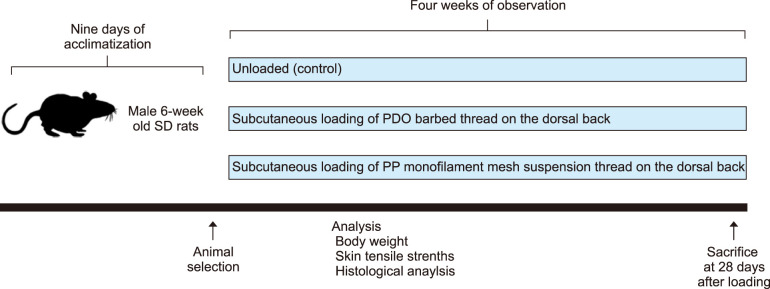
Fig. 2
Photograph of polypropylene monofilament mesh suspension thread (RaiseMeUpTM; Prestige Medicare Co. Ltd., Seongnam, Korea).
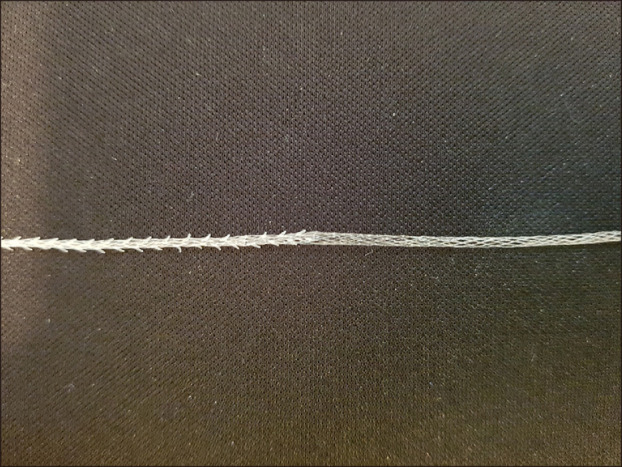
Fig. 3
Body weight changes. There were no significant changes in the body weights of rats in groups B or C compared to rats in group A throughout the 28-day loading period. Before: 1 day before subcutaneous loading. The rats were sacrificed on day 28 after loading. All animals were fasted overnight before subcutaneous loading (dotted arrow). Group A: unloaded (control), group B: subcutaneously loaded with polydioxanone barbed thread (MIRACU™), group C: subcutaneously loaded with polypropylene monofilament mesh suspension thread (RaiseMeUp™).
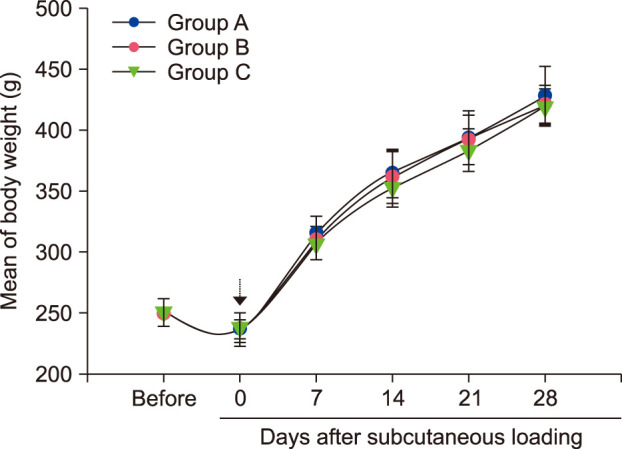
Fig. 4
Representative gross findings. There were no serious gross findings around sites loaded with polydioxanone (PDO) barbed thread or polypropylene (PP) monofilament mesh suspension thread compared to control sites. Squares indicate remnant loaded materials. Group A: unloaded (control), group B: subcutaneously loaded with PDO barbed thread (MIRACU™), group C: subcutaneously loaded with PP monofilament mesh suspension thread (RaiseMeUp™).
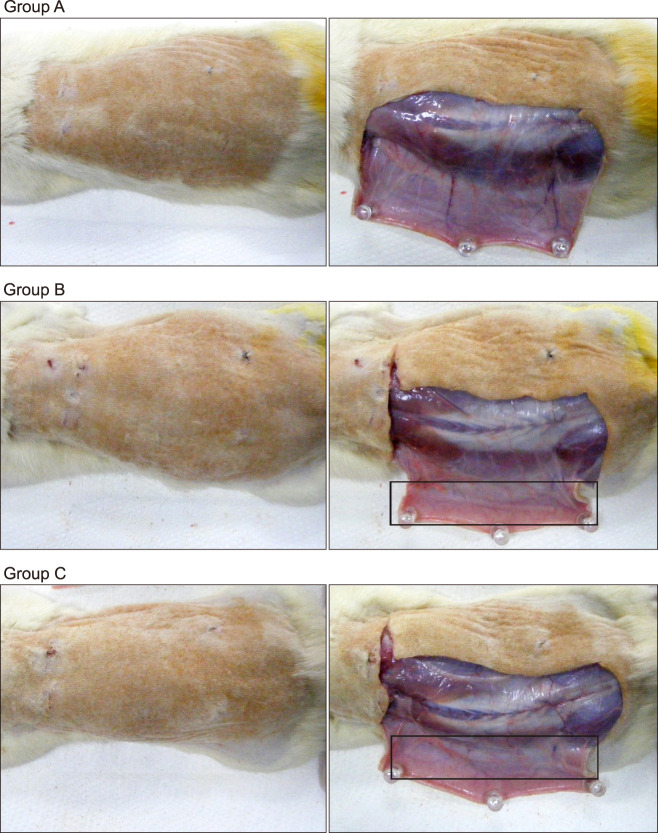
Fig. 5
Tensile strength on the dorsal skin. Significant increases in skin tensile strength were determined in groups B and C compared to group A, with and without remnant loaded thread. Values are expressed as the mean±standard deviation of the data from eight rats. Group A: unloaded (control), group B: subcutaneously loaded with polydioxanone barbed thread (MIRACU™), group C: subcutaneously loaded with polypropylene monofilament mesh suspension thread (RaiseMeUp™).
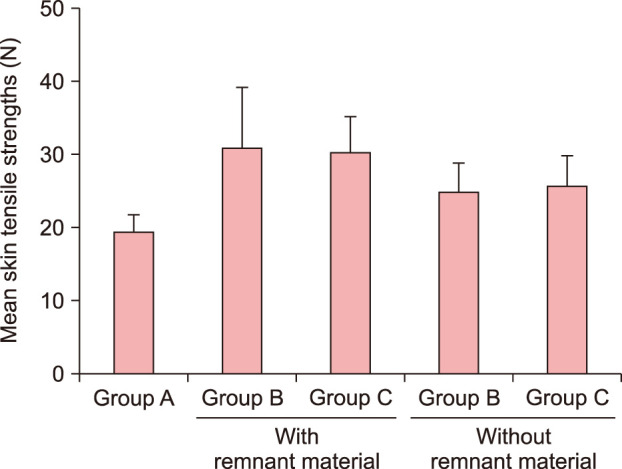
Fig. 6
Histological profiles of dorsal skin tissues around loading sites. Based on measurements from the hematoxylin and eosin (H&E) stained sections (A), the mean diameter of the remnant material in group B was 586.25±26.25 µm, and the mean diameter of the remnant bundles in group C was 574.77±31.60 µm. Bundles with a mean diameter of 120.77±6.25 µm were detected 28 days after loading and were well localized to the loading sites. The mean inflammatory cell grade around loading sites was significantly higher in group B than in group A rats. On the toluidine blue (TB) stained sections (B), the mast cell infiltration around the loaded regions of the dorsal skin did not significantly differ between groups B and C and control group A rats. In the Masson's trichrome (MT) stained sections (C), significant increases in collagen fibers were evident in group C compared to either group A or group B (p<0.05).
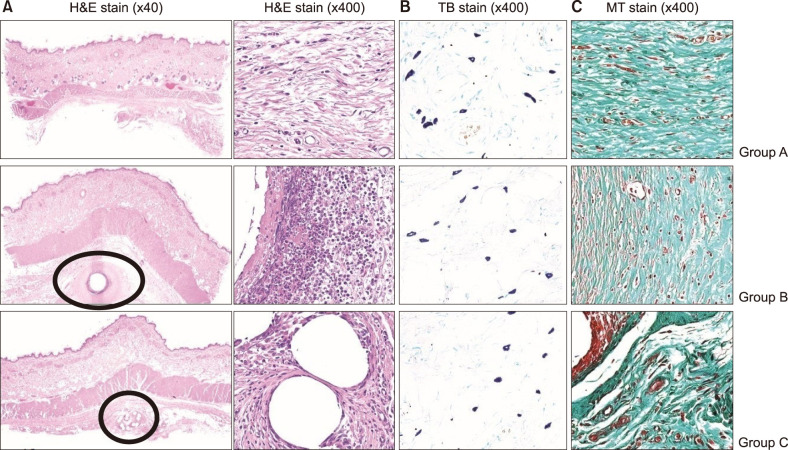
Table 1
Experimental design used in this study

Table 2
Classification of inflammation grade
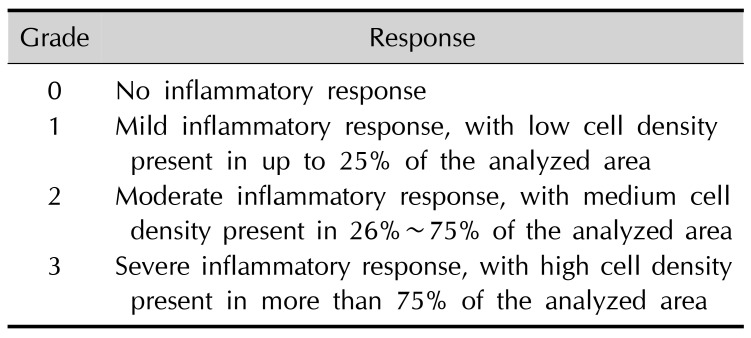
Table 3
Body weight gains in intact rats and those loaded with test materials

Values (g) are expressed as the mean±standard deviation from eight rats. Group A: unloaded (control), group B: subcutaneously loaded with polydioxanone barbed thread (MIRACU™), group C: subcutaneously loaded with polypropylene monofilament mesh suspension thread (RaiseMeUp™), *All animals were fasted overnight (~18 hours; water was not restricted).
Table 4
Histomorphometric analysis of regions around subcutaneously loaded sites





 PDF
PDF Citation
Citation Print
Print



 XML Download
XML Download